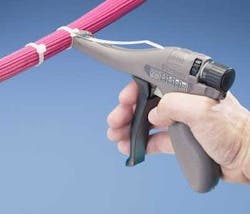All tied up in network efficiency
Maximizing network efficiency is the primary goal of a telecommunications system, and good installation practices are essential to assure high performance of the cable run. Yet, the practice of installing cable ties around a bundle of cable is rife with potential trouble.
Improper cable-tie bundling can lead to possible transmission losses and safety concerns, while over-tensioning ties can cause cable stress. Jagged or long cable-tie cut-offs can damage valuable network cable, injure your hands or even snag clothing.
Choosing and using the proper cable-tie installation tool prevents the hazards, and also decreases the potential for network-performance degradation. Extensive laboratory tests and on-the-job applications over long time frames have given the cable-tie industry proven criteria to help you make the best choices for the task at hand.
Modern tools and cable ties have surpassed the methods previously used for installing cable ties, making the finished product uniform and providing a simple, fast, efficient way of curing cable stress. If a cable tie is installed too loosely, the cable bundle is not contained properly. If a cable tie is excessively tightened, signal performance can be diminished. Today, cable ties and tie tools designed specifically for communications cables can solve these problems.
Avoiding stress
You can't achieve consistent tightness of cable bundles by hand-tightening cable ties. Heed this advice given in TIA/EIA-568B.1: "Cable stress caused by tension in suspended cable runs and tightly cinched bundles should be minimized. Cable ties used to bundle cables should be applied loosely to allow the tie to slide around the cable bundle. The cable ties should not be cinched so tightly as to deform the cable sheath."
null
Stress is created when the integrity of the twisted pair of conductors is disturbed. The distance between conductors should remain fixed and stable along the cable's length. Overstressing the conductors by kinking the cable or overtightening ties can change the conductor spacing, which upsets cable stability and causes problems with return loss and crosstalk.
Controlling tension
Cable ties installed by hand often are overtensioned when you grip the body with lineman's pliers, then rotates it, using the head as a fulcrum. Normally, you then cut off the tail, leaving a high, sharp cut-off above the head. Unfortunately, this practice does not result in consistent, reliable, performance-ready or safe installations.
A controlled-tension cable-tie installation tool grips and tensions the tie to a preset tension, and automatically cuts it off. There is little chance for error, and the customer has assurance that the proper tension is repeatable and consistent from worker to worker. The operation is quick and reliable, and results in dependable after-installation cabling performance.
Some modern, high-quality cable-tie installation tools provide a tension adjustment feature. Because several installers may use a single tool, the ability to lock the tool's tension setting is a feature that helps protect against incorrect tensioning.
Also, ergonomic tools offer "user-friendly" features, including low handle force for comfort, reduced fatigue, and reducing repetitive-motion injuries. These features probably will come into play on large jobs with long runs and multiple bundles.
null
Another feature to consider is a rugged build, especially if the tool will be used in industrial environments.
In smaller, confined spaces, such as inside cabinets and racks, reach-in injuries from sharp tie cut-offs are frequently a hazard. They can be avoided by using a controlled-tension tool that properly cuts off ties. A tool with a thin blade guard that fits close to the tie head will provide flush cut-offs on all types of ties.
For extra insurance inside cabinets and racks, use parallel-entry ties that further limit exposure to sharp cut-off edges. These unique ties let the smooth side of the strap be in contact with the cables—a characteristic that is effective in lowering stress points.
Properly installed cable ties will not only help prevent transmission losses in your telecommunications system, but also will lead to a safe, quality, and reliable installation. The latest innovations in cable-tie installation tools can help you achieve this objective. Versatile tooling and cable-tie options are available, so look closely at your application requirements and carefully examine product features and benefits.
Jim Brownlee is assistant chief engineer with Panduit Corp. (www.panduit.com).


